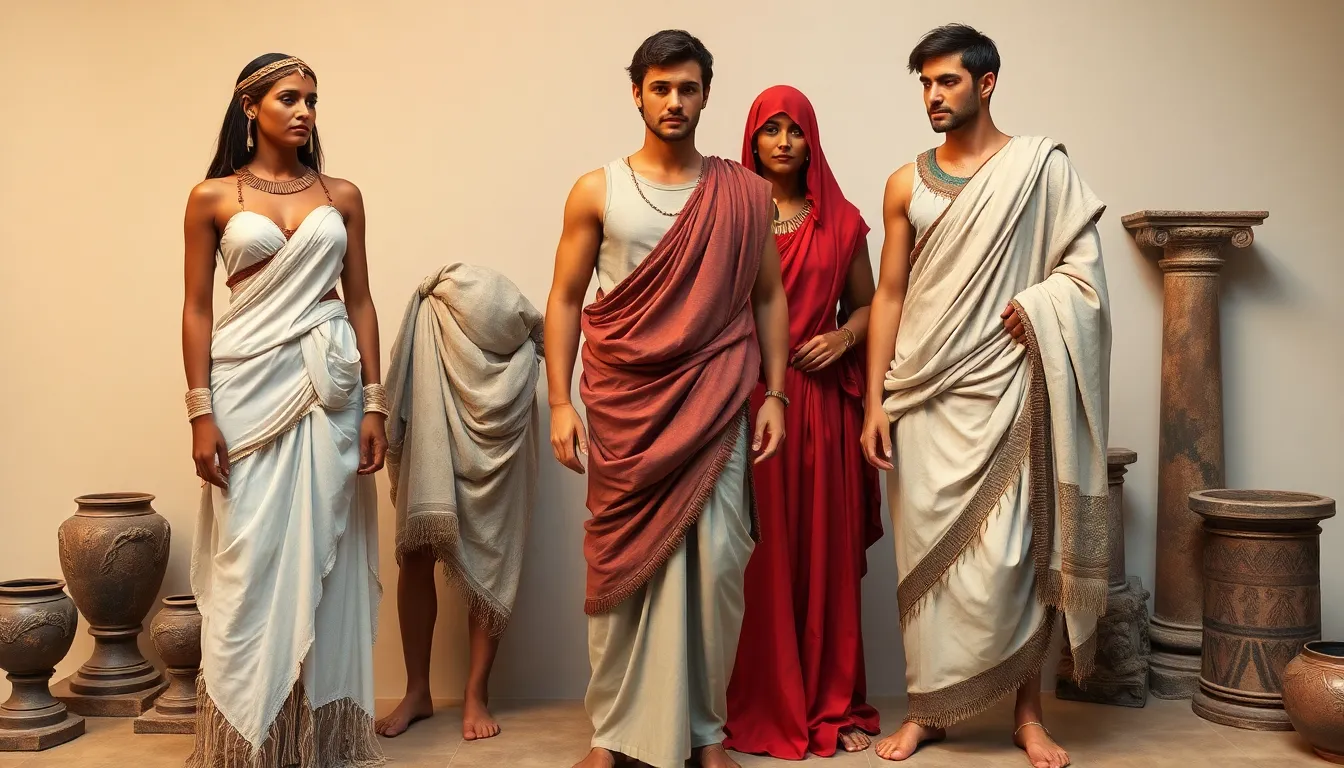Fashion history isn’t just a timeline of trends; it’s a wild ride through human creativity, culture, and the occasional questionable choice (leather pants, anyone?). From the opulent gowns of the Renaissance to the rebellious styles of punk rock, each era tells a story that reflects society’s values, struggles, and aspirations.
Imagine strutting down the street in a powdered wig or a corset that could double as a medieval torture device. Fashion has always been a powerful form of self-expression, and understanding its history reveals how style has shaped identities across generations. Buckle up as we explore the fascinating journey of fashion, where every stitch and seam weaves a tale worth telling.
Table of Contents
ToggleOverview of Fashion History
Fashion history encompasses a timeline of styles, practices, and movements that reveal cultural narratives. Early fashion, evident in ancient civilizations, employed materials like wool and linen, highlighting status and function. The Middle Ages introduced garments such as tunics and cloaks, which varied among social classes. During the Renaissance, vibrant colors and luxurious fabrics showcased individualism and wealth.
The 18th century marked a shift towards elaborate clothing. Rococo styles emerged with intricate patterns and asymmetrical designs, emphasizing ornate aesthetics. In contrast, the Industrial Revolution democratized fashion through mass production. This era gave rise to ready-to-wear clothing, making garments accessible to the general public.
The 20th century experienced rapid transformations, characterized by distinct fashion movements. The flapper era of the 1920s celebrated women’s liberation with shorter hemlines. Meanwhile, the 1960s ushered in counterculture fashion, merging art with everyday attire. Punk rock styles in the late 1970s defied norms, blending rebellion with creativity.
Fashion continues to evolve in the 21st century, reflecting globalization and technological advances. Influences from social media shape trends, allowing diverse voices to emerge. Sustainable fashion practices address environmental concerns, pushing the industry towards ethical standards. Each era adds layers to the complex narrative of fashion, illustrating its role as a mirror of society’s values and aspirations.
Ancient Civilizations and Their Styles

Ancient civilizations set the stage for fashion innovation, using materials and designs that revealed societal values and cultural significance.
Egypt: Linen and Jewelry
Egyptians favored linen for its breathability in the warm climate. This lightweight fabric, often woven from flax, symbolized purity and was commonly worn by both genders among the elite. Jewelry played a crucial role, with gold and semi-precious stones demonstrating wealth and status. Amulets were also popular, meant to provide protection and denote social standing. Elaborate headdresses adorned with intricate designs completed their outfits, further emphasizing elite status in both everyday life and burial practices.
Greece: Draping and Elegance
Greeks excelled in creating garments that draped elegantly around the body. The chiton, a type of tunic, displayed versatility in style and often featured lightweight fabrics like linen and wool. Citizens draped their clothing in ways that emphasized form while allowing for freedom of movement. Himation, a cloak worn over the chiton, added layers to their outfits, promoting a profound sense of sophistication. Greek fashion reflected ideals of beauty and harmony, connecting clothing to the cultural emphasis on aesthetics and philosophy.
Rome: Togas and Status
Romans distinguished themselves through the toga, an important symbol of Roman citizenship. Made from wool, this garment’s draping style indicated status and social class. Only freeborn men wore togas, emphasizing the exclusive rights of citizenship. Women wore stolas, which were long dresses layered over tunics, showcasing elegance and modesty. Colors and decorative elements conveyed social hierarchy, with distinct variations for different occasions. Thus, Roman fashion represented both practicality and an assertion of identity within the vast Empire.
The Middle Ages: Layering and Function
The Middle Ages marked a dramatic evolution in fashion, blending functionality with layered aesthetics. Garments signified social status while addressing practical needs.
Fashion in Courtly Life
Courtly life established clear distinctions in dress among nobility. Wealthy individuals adorned themselves in luxurious fabrics like silk and velvet, showcasing their status. Common clothing consisted of simple tunics made of wool, featuring modest designs. Accessories such as elaborate brooches and jewelry highlighted rank and influence. Styles varied widely across regions, illustrating local customs and available materials. The intricate layering of garments, including surcoats and capes, added visual complexity, while demonstrating craftsmanship and opulence.
The Rise of Tailoring
Tailoring emerged as a specialized craft during this period, changing how garments were constructed. Skilled tailors focused on fitting clothes more precisely, enhancing comfort and mobility. Blocks of patterns allowed for greater customization, accommodating individual body shapes. As techniques improved, garments began to exhibit structured silhouettes instead of loose draping. Tailored pieces, such as fitted bodices and long gowns, became synonymous with higher social classes. This shift influenced future fashion, laying the foundation for modern garment construction and design practices.
The Renaissance: Art Meets Fashion
The Renaissance marked a significant turning point in fashion, blending creativity and individual expression. Fashion during this era reflected the revolutionary ideals of art and literature, embodying shifts in cultural perspectives.
Influence of Art and Literature
Art significantly influenced fashion during the Renaissance, with artists serving as trendsetters. Artists like Leonardo da Vinci showcased fashion in their paintings, combining realism with beauty. Literature also played a role; works from writers such as Boccaccio inspired new ideas about style. Clothing became an extension of artistic expression, making garments as much a canvas as paintings. The use of intricate designs, vivid patterns, and symbolic imagery in fashion drew heavily from visual art. The social elite adopted styles that mirrored the beauty found in artworks, further intertwining the worlds of art and attire.
Fabrics and Colors of the Era
Fabrics defined Renaissance fashion, with a preference for luxurious textiles. Velvet, silk, and brocade dominated the wardrobes of the wealthy, reflecting both status and wealth. Colors conveyed various meanings, with deep hues like crimson, gold, and azure signifying nobility. Additionally, natural dyes created vibrant, long-lasting colors that enhanced garment appeal. Tailoring evolved, allowing for more fitted and elaborate designs. Across various regions, unique fabric choices and color combinations represented local traditions. This diversity echoed the vibrant artistry of the era, uniting fashion with cultural identity.
The 19th Century: Industrial Revolution and Change
The 19th century marked a pivotal period in fashion history, transforming the industry through innovation and social change.
The Birth of Ready-to-Wear
Ready-to-wear clothing emerged as a significant shift in fashion. Mass production techniques allowed for garments to be manufactured in standard sizes. Factories began producing clothing at a rapid pace, making it more affordable for the middle class. Styles rolled off assembly lines and made fashion accessible, moving away from exclusive bespoke tailoring. This democratization of fashion changed consumer habits. Shoppers flocked to department stores to find the latest trends without the need for custom fittings. The industrial revolution laid the groundwork for a new relationship between consumers and fashion.
Fashion Icons of the Century
Fashion icons began to rise during the 19th century, shaping styles and influencing society. Figures like Queen Victoria became symbols of modesty and femininity, popularizing the crinoline dress. Charles Frederick Worth revolutionized the industry as the first couturier, creating a brand around his name. His designs adorned the elite, solidifying his status in fashion history. In Paris, feminine silhouettes evolved with corsets defining the hourglass figure. Men’s fashion also saw change, with tailcoats and waistcoats becoming popular. These icons not only defined eras but also reflected societal values through their distinctive styles.
The 20th Century: From Modernism to Counterculture
The 20th century represents a period of intense fashion evolution, reflecting societal shifts and artistic movements.
Key Designers and Movements
Christian Dior revolutionized women’s fashion with the “New Look” in 1947, emphasizing femininity through structured silhouettes. Yves Saint Laurent later challenged conventions by popularizing ready-to-wear and introducing the tuxedo jacket for women in the 1960s. Coco Chanel’s timeless designs, including the little black dress, made a lasting impact by prioritizing comfort and elegance. Furthermore, designers like Pierre Cardin embraced avant-garde aesthetics, incorporating geometric shapes and unorthodox materials. The rise of street style in the 1970s, led by figures like Vivienne Westwood, merged fashion with punk culture, reflecting rebellion and individuality. These designers and movements collectively shaped a dynamic landscape where personal expression intertwined with broader societal changes.
Impact of War on Fashion Trends
World War I prompted practical changes in women’s clothing, as fabric scarcity resulted in shorter hemlines and more functional attire. During wartime, utility became paramount, leading to the adoption of simpler designs that emphasized versatility. World War II continued this trend, introducing rationing measures that influenced fabric choices and garment construction. The “Make Do and Mend” campaign encouraged creativity and resourcefulness, fostering innovative repurposing of clothing. Post-war, a desire for optimism surged, leading to lavish styles and an embrace of femininity in fashion. The contrast between wartime practicality and peacetime exuberance illustrates fashion’s ability to adapt to societal needs while reflecting cultural sentiments.
Contemporary Fashion: A Global Perspective
Contemporary fashion reflects dynamic shifts in culture and society, showcasing a blend of creativity and innovation. This section explores key elements shaping modern fashion.
Sustainability in Fashion
Sustainability has emerged as a vital consideration within the fashion industry. Brands increasingly adopt eco-friendly materials and processes to minimize environmental impact. For example, companies like Stella McCartney prioritize ethical practices, using organic cotton and recycled fabrics. Consumers demonstrate a growing preference for sustainable options, leading to increased transparency and accountability among brands. Supply chain transparency has become crucial, enabling consumers to understand the origins of their clothing. Moreover, initiatives like the Fashion Industry Charter for Climate Action encourage collective efforts to reduce carbon emissions within the sector. Sustainable fashion fosters a more responsible industry that respects both people and the planet.
The Role of Technology
Technology plays a significant role in transforming contemporary fashion. Innovations in textile production, such as 3D printing, revolutionize how garments are designed and manufactured. This technique allows for greater customization and reduced waste. Furthermore, augmented reality (AR) enhances shopping experiences, enabling virtual try-ons and interactive experiences. Social media platforms drive trends quickly, with influencers shaping consumer preferences worldwide. Additionally, artificial intelligence (AI) analyzes consumer behavior, assisting brands in inventory management and trend forecasting. As technology continues to evolve, it greatly influences the way fashion operates, creating a more connected and responsive industry.
Fashion history serves as a captivating tapestry woven from human creativity and cultural expression. Each era contributes unique styles and movements that reflect societal values and aspirations. As fashion continues to evolve in the 21st century, its connection to identity and self-expression remains strong. The industry’s shift towards sustainability and innovation highlights its adaptability in addressing contemporary challenges. Understanding fashion’s rich past not only enriches appreciation for current trends but also inspires future generations to explore their own creative journeys.










